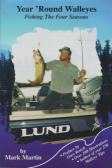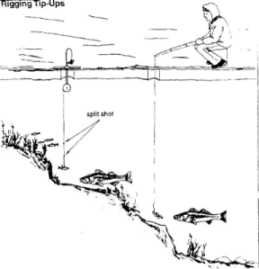 |
|
|
First ice Stealth Tricks
First Ice can really present a myriad of conditions, much like open water. If the ice is milky and light penetration is inhibited then I need to take very few precautions against spooking fish. However if the ice is clear and I can see through it, then we need to compensate. I do this one of two ways. If there is snow on the ground, I drag a sled of it with me out to the holes. I spread the snow around me so that fish cannot see my silhouette up on the ice. In the absence of snow, I’ll use a piece of white carpeting. Don’t use dark carpeting because it will absorb heat and melt the ice underneath it. Both of these tricks make me less intrusive into the fish’s environment and result in more bites from less wary fish. This leads me into the subject of stealth. During first ice, the fish can become spooky. The water is amazingly clear, and light can penetrate very easily through the thinness of the ice. I travel light and carry a minimum of gear. A critical factor in this is drilling my holes. I use a StrikeMaster Lazer hand auger to drill the holes, rather than a gas powered auger or using a spud. If you create too much commotion on the ice, you may spook the fish away for several hours. The StrikeMaster Lazer hand auger is sharp and cuts quick making it the most silent approaches I’ve found.  By MarkMartin By MarkMartin
From Year' Round Walleyes Fishing the Four Seasons  To find out more about
getting a copy of this fine book
click here To find out more about
getting a copy of this fine book
click hereThe first thing I do when setting up is to drill four or five holes for each person in the party. Spread the ice holes out throughout the area over good structure, and don’t forget the edges and tops of dropoffs, reefs and weeds. Drill some holes over the bottom of the dropoff even if it’s 30 to 50 feet deep. Do this and you will be warm by the time you’re done. Once fish start hitting at a certain depth, stay at that depth for at least an hour unless a nearby angler starts catching fish in deeper or shallower water. If that happens, it’s time to make a decision. Show some courtesy while ice fishing; don’t move in tight to another fisherman. Move shallower or deeper, but in the same line and depth as the person who is catching fish. And above all avoid making unnecessary noise. If the action is slow during the day, fish right along the bottom at the drop-offs lowest area or where the lake bottom connects to the drop-off. This can be a hotspot. Light causes movement. Early in the day, when the sun is still low, fish may be in shallow water. Walleyes are very skittish in shallow water under the ice so as the sun comes up or cloud cover moves out, the fish will move to the edges, into the weeds or into deep water. This means anglers must move with them. If holes have been drilled in advance, just walk to the new hole and start fishing without making a lot of extra drilling. When fishing with a friend or two, start out with each person trying a different lure and presentation. This can shorten the time needed to find out what the fish are looking for and can result in faster walleye catches. Traditional jigging is the most common technique used to catch walleyes.
A leadhead jig like Northlands two tone Fireball or foxes stand-up head,
a flash lure like A little fresh meat will make a big difference when ice fishing. The taste and texture of fresh meat will produce more strikes and hold the fish longer, which gives anglers more time to set the hook. Laws vary from one state or Canadian province to another, but where
it is legal anglers can use a whole minnow, a piece of cut up minnow or
perch eye to ad flavor and meat to an ice fishing presentation. Try adding
a small minnow to each barb of the treble hook of a Jigging Drop the baited lure to the bottom and lower the rodtip to the water level on a tight line. Raise the rodtip six inches and sharply lift it a foot before immediately dropping the tip. This cause the lure to flutter, fall or swim back down. I jig once every two or three seconds or five or six times in a row, and then stop to let things settle down for a few seconds. Then start jigging again. Strikes often come as the lure falls or just as upward jigging stroke starts again. Watch the line closely, and be ready for a hit.
Bottom Skipping is much like traditional jigging except the jig or lure touches bottom each time. The lure-tapping bottom will stir up silt, sand or mud and this creates the illusion of a feeding or injured baitfish. This techniques works best in gravel or rocky areas. Bottom-Upping is similar to bottom skipping. Place the lure at or near the bottom and twitch it up and down three inches at a time to stir up the bottom with a continuo motion. Keep the line tight and thump bottom. Pause occasionally and allow the lure to lay on bottom or hold it just off bottom in a cloud of silt. This also works best in rocky areas Tight Line Twitching is a more delicate method than any of the above. With Tight line twitching lures don’t lift and fall. Instead keep a constantly tight line. Except for an occasional twitch, the lure just walks around in a circle over the bottom. Swishing is similar to jigging but it has a side to side movement rather than up and down. Move the rodtip back and forth, from side for three to six inches at a time. This causes a rocking or pendulum motion in the lure. It doesn’t move up and down instead it just slides and twitches from side to side. Throw an occasional vertical jig to add some variation. As in tight line twitching, when a walleye hits the strike is easily felt because the line is tight. This is a great technique for beginners who have trouble feeling a strike with a more conventional jigging methods.
Jigging will make a bait look like a nervous wreck. Move the wrist up and down rapidly one to two inches while slowly lifting and lowering your arm. Underwater walleyes will see a lure dancing wildly, swimming up and down, from deep to shallow depths, and back again. This is a good technique to find the depth of the fish but remember to pause occasionally at the bottom, middle and top of the stroke. Mix these tactics up and have fun. An angler will be like a dancer who’s
been around and knows the steps. Mix and combine these techniques. Try
jigging, skipping, bottom upping, twitching, swishing and tight lining.
Just remember what works and keep doing it
Rigging Tip –Ups  By MarkMartin By MarkMartinIt’s wise to fish with two rods or a rod and a tip-up if the law allows in your state. It doubles the odds of hooking fish, and gives fisherman a better idea of what fish want on any given day. Once a pattern develops, it is easy to adjust. For tip-up fishing, choose healthy, two to three inch chubs, shiners or suckers. Check tip-ups carefully to determine if the spool spins freely as a walleye runs off with a minnow.
A walleye will drop the bait if it feels any hesitation. Set the minnow six to 24 inches off the bottom. I use one small splitshot six inches above the minnow and another about 12 inches above that so the minnow can move naturally but will stay where I want it. When a tip-up flag goes up, walk quirtely to the hole and give the fish time enough to swallow the bait. Slowly take up line hand over hand untill you feel the fish, and then quickly bring in the line and set the hooks in one smooth motion. When using a tip-up, try to use the smallest possible bobber and attatch it to the line. Once water depth has been determined, set the minnow depth so the bobber is just below the tip-up line spool. With a bobber it is possible to tell if it was a minnow, walleye or wind that triggered a release. Check the bobber location. A big fish will take line out, and
the bobber will be out of sight under the ice. This simple test will
eliminate having to reset or recheck the bait whenever a flag goes up
Please visit these site sponsors |
|---|---|

 Anglers will occasionally
feel the lure being sucked in. Other times the line will stop before it’s
supposed to and that is when a walleye has short stopped it on the way
down. Be ready to set the hook at all times
Anglers will occasionally
feel the lure being sucked in. Other times the line will stop before it’s
supposed to and that is when a walleye has short stopped it on the way
down. Be ready to set the hook at all times



